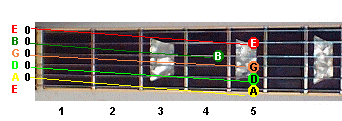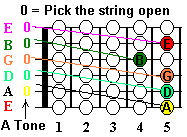Join us today and learn how to play the guitar right!

Welcome to Guitar Secrets
Guitar Lessons that work!
[ Guitar notes ] [ Sharps and flats ] [ Guitar Exercises ] [ Picking Exercise ] [ Guitar Tablature ] [ Guitar Tuning ]
Guitar Tuning Instructions. How to tune your guitar
Watch this YouTube video to learn how to tune your guitar. You really should own a guitar tuner.
So you’re asking, “how do I tune my guitar”? Well, there are many ways to tune your guitar and of course the easiest and most accurate way, is to use an electronic guitar tuner. However, the guitar’s intonation must be set properly for your guitar to sound accurate.
You can find guitar tuners that work with the acoustic guitar, electric or both. An acoustic guitar tuner will have a built in mic, to pick up the sound of each string. Electric guitar tuners usually have an input jack to plug in the guitar and at times also the mic.
It is highly recommended that everyone own some type of guitar tuner. However, I strongly suggest you learn to tune your guitar with one note off a fixed source or by ear. This will not only help train your ear to the pitch of each note, but will help with finger placement and pressure applied to the guitar string.
The open A note, for tuning your guitar, has been included to assist you. Open A for tuning. If you have windows media player, you can set the sound to repeat. This will be in the media’s option file. If you set it to repeat, you can listen to it many times over and not have to mess with it. It’s a good idea to learn to tune by ear. I’ve also included a video to show you the tuning technique.
Tuning the (A) or 5th string.

The most basic way of tuning your guitar will start with the open (A) string. This is the second largest string, which is called the 5th string. By using the fixed source, piano, harmonica, tuning fork, another guitar or the A note supplied, we will tune the A string. You will now tune the (A) string to match the pitch or tone of the A source. Pick the A string open and let it ring out or sustain. Picking the A string open, means to pick the string without fretting the note. (Fretting, pushing down on the string).

I find by loosening the string below the tone and raising or tuning while increasing the string’s tension works best and tends keep the guitar in tune longer. So, once you establish that A tone and match it with the open (A) string, you are ready to move on to the next string. Remember, don’t tune while loosening the string, only while tightening.
Tuning the (D) or 4th string.
Now that you have the A string matching the pitch of the A source, you’re ready to move onto the D string. The D or 4th string is directly below the A string. By fretting or placing your middle finger on the (fifth fret) of the A string and picking it, you would be playing the D note. Look at the image below and find the D note on the 5th fret of the A string. This note should be held down and left to ring or sustain while adjusting the D or 4th string to match the D tone. It may take a few times to match up, but remember to always match the tone while tightening the string and not while loosening.

Tuning the (G) or 3rd String.
Now that you have the D string matching the A string at the 5th fret, we can move onto the G string. The G string is directly below the D string. By fretting or placing your middle finger on the D string, fifth fret and picking the string, you sound the G note. Once again, let the note ring out by holding your middle finger down while adjusting the G string to match the sound of the G note played at the fifth fret. Look at the image below and you can see the G note at the 5th fret of the D string. Play that G note and then adjust the G string to match that tone.

Tuning the (B) or 2nd String.
The B string is directly below the G string. Fretting the G string with your index finger at the fourth fret, will sound the B note. Let this note ring out and adjust the B string to match this tone of the B note.

Tuning the (High E) or 1st String.
The high E string is the thinnest string and below the B string. Fretting the B string with your middle finger, at the fifth fret, will sound the E note. Let this note ring out and adjust the E string to match that of the fifth fret B string.
Tuning the (Low E) or 6th String.
Finally our last string. The Low E string or 6th string is the thickest or heaviest string. By placing your middle finger on the fifth fret of the Low E string will sound the A note. Let that note ring out and pick the (A) string open and match the E string, 5th fret to the open A string.
There’s a cool technique to use once you become familiar with tuning your guitar. If you find that some of the guitar strings are too high or the tuner indicates that the string is sharp, you can pinch the string towards the middle of the fret-board and pull up on the string. When you pull up on the string, you can lower the pitch slightly and bring the string in tune. You don’t want to pull too hard. This technique is a must when you replace your strings. New strings really need to be stretched out a few times. Eventually they will stay in tune. It’s also a good idea to wipe down your strings after each use. By wiping the moisture and oils from your hands you can extend the life of the guitar strings.
Good Luck,
Guitar Secrets

